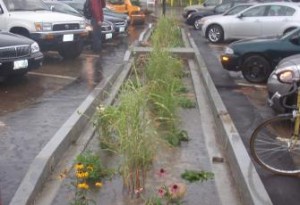Great Bay Municipal Bioretention Program (Biopalooza)
The Great Bay Municipal Bioretention Program, also known as Biopalooza, is a NHDES funded project with the University of New Hampshire Stormwater Center (UNHSC) that will assist partnering municipalities in implementing strategies for watershed pollutant load reduction. The project goal is to build municipal capacity to effectively mitigate non-point source pollution. The program has four primary phases:
- Phase 1 includes the development of updated impervious cover (IC) analysis for Rockingham and Strafford counties. This will provide 40 of the 42 NH coastal communities with updated IC data that can be used for planning, modeling, and tracking applications. A GIS model will be developed for partnering municipalities to identify locations where high projected pollutant load areas overlay with other high threat features, such as specific land use types. This will provide a coarse overview of potential hotspots for sediments, phosphorus, and nitrogen to help direct and improve municipal stormwater management efforts. Four partnering communities have been selected for the project (Stratham,Greenland, Epping, and Durham) and the impervious cover data sets have been developed. The UNHSC is now working on the optimization model which should be completed by the end of February, 2013.
- Phase 2 involves installation of high-impact, high-visibility municipal bioretention systems in partnering communities. The systems will be sited, designed, and installed, in partnership with municipal staff, design engineers, and UNHSC personnel. Installations will be owned and maintained by the municipality and the IC data will be used to develop pollutant load reduction estimates from the project. One design has been completed in cooperation with Geosyntec Consultants and the town of Stratham, NH. The installation is scheduled for the Spring 2013. Other locations are currently under discussion with town partners.
- Phase 3 includes the development of an internet-based resource to facilitate bioretention implementation from design to installation. Through collaboration with theUNHStormwater Center (UNHSC), the Southeast Watershed Alliance (SWA), Regional Planning Commissions, municipalities, design firms, nurseries, and landscape professionals, designs and resources will be developed and made available online for future projects. UNHSC and SWA are currently investigating web design options and a draft web page should be available in the Summer of 2013. The website will be hosted by SWA.
- Phase 4 is comprised of an extensive outreach campaign led by SWA in partnership with the UNHSC to work with communities in how to best use the Impervious Area and Land Use analyses for targeted non-point source (NPS) management. Phase 4 should commence in the Fall of 2013.
If you are interested in additional information or becoming a project partner please contact James Houle, UNHSC Program Manager, e-mail: james.houle@unh.edu

